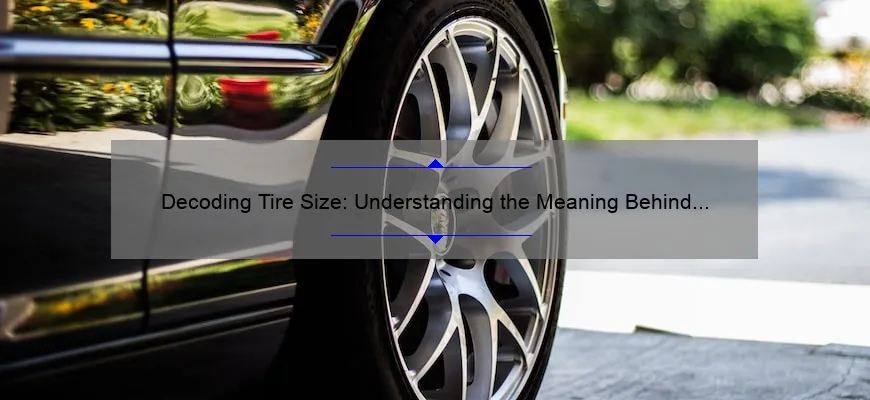Short answer: What do the size of tires mean?
The numbers and letters on a tire’s sidewall provide information about its size, including width, aspect ratio, diameter, load capacity, and speed rating. Understanding these codes is essential when selecting replacement or performance tires for your vehicle.
A Step-by-Step Guide to Deciphering Tire Size Markings
Tires are one of the most important parts of your vehicle. They help maintain traction, improve handling, and ensure road safety. But what do all those numbers and letters on tire sidewalls actually mean? Deciphering tire size markings can be a daunting task for many car owners. However, it is essential to know how to read them as they provide crucial information about tire type, size, load capacity, and speed rating.
So let’s dive in – here is a step-by-step guide to decoding tire size markings:
Step 1: Look at the Size Code
The first thing you should examine is the size code; it appears at the beginning of every tire designation label. It consists of three numbers that indicate section width (in millimeters), aspect ratio (percentage comparison between height and section width), and rim diameter (in inches) respectively.
For example, if your tire reads “225/50R17”, you can identify that its section width is 225mm while its aspect ratio stands at 50%, with a radial construction represented by the letter ‘R’. The last number indicates this tire requires a wheel with a diameter of 17 inches.
Step 2: Check Load Capacity Index
Another critical value within these codes is the load capacity index marked after the aspect ratio or near enough which refers to how much weight each individual tyre has been designed to carry safely when inflated properly under recommended conditions. This numerical figure usually ranges from around seventy-five upwards going beyond two-hundred marking heavier commercial tyres made for large vehicles such as trucks or buses where the need arises.Without proper care in selecting an appropriate number,you may compromise not only safety aspects but void warrant appertaining among other damages incurred during driving experience caused by wrong tyre selection leading potentially disastrous consequences in extreme scenarios unnecessarily exposing all parties involved including yourself plus innocent parties too won’t hurt understanding this sensitive part well.
Step3 : Consider Speed Rating
The next value following the load capacity index is speed rating symbol indicated by a letter together with reference numbers located after it. This code signifies the prioritized maximum permissible operating speeds determined through tire company research done to determine how fast the vehicle tyres can move while carrying their recommended load capacity limit without getting excessively heated leading them to burst if driven for extended periods.
You may see numerous charted alphabets starting at A and ranging up Y, each representing a specific range of possible top legal driving miles per hour limits such as S (180 km/h), H (210km/h) or ZR which uses different ranges altogether beyond 240 k/hr positioned on ultra high-performance vehicles only making sure you pick one ideal for your vehicle type hence avoiding catastrophic accidents caused by undue pressure over speeds exceeding capable safety precautions thus prompting need of knowing what options are available before fitting-in any tyre that would lead future regrets thereafter.
Step4 : Verify Age & Origin
It might be helpful also to confirm age and origin details written sequentially marking something like ‘DOT U3EE’ signifying date manufacture showing month then year produced in addition country manufactured represented through letters appearing somewhere within this variety example helping regulators track defective types arising from some manufacturers who’ve been investigated before indicating poor quality components too requiring immediate attention when discovered raising awareness among those looking for replacement units ensuring correct specifications like absence serial printing ending mostly coded six-digits but could go upto twelve characters depending size model.
In conclusion, deciphering tire size markings is not rocket science but an essential aspect every driver should comprehend. By carefully studying these codes, you will gain critical insight regarding whether particular choices conform fitment specifications suitable performance capabilities designed with utmost integrity providing excellent handling regardless unpredictable conditions surrounding users adheres safety standards prevent fatalities yet unresolved manufacturer issues reported time again arise thereby necessitating well informed decisions taken ensure public welfare remains priority always. So take a good look at your own cars Tyre used today!
Frequently Asked Questions on What the Size of Tires Mean
Tires are one of the most crucial parts of any vehicle, whether it’s a car or a truck. You need to have a good understanding of tire size if you want to maintain optimal performance and safety on the road. One thing that confuses many people is what the numbers and letters on tires actually mean. In this post, we’ll answer some frequently asked questions about tire sizes.
Q: What do the numbers and letters on tires represent?
A: The first part of the code represents the tire width in millimeters. The second part is called an aspect ratio, which is expressed as a percentage of the width. This gives you an idea of how tall or low-profile your tire will be. The letter following these two numbers signifies the construction type – “R” stands for radial whereas “D” corresponds with bias-ply construction.
Q: Why does tire diameter matter?
A: Tire diameter affects acceleration, braking distance, fuel efficiency, handling around curves – everything! It’s vital that you select appropriate sized wheels based off operation conditions such as speed ranges and payload capabilities for work vehicles amongst other things to ensure optimum safety whilst driving.
Q: Can I put larger/smaller tires than recommended by manufacturer?
A: It depends on several factors like maximum allowable wheel diameter size & load capacities specified by both manufacturers i.e., original auto makers’ suggested limit versus aftermarket add-on limits amidst other variables specific which must match closely pre-specified criteria when making modifications; therefore going beyond prescribed segmentation may cause unforeseen potential problems resulting in negative consequences while operating motor vehicles so choose wisely!.
Q: What do “Z,” “H,” “V” ratings stand for?
These ratings reflect different top speeds at which each particular type can safely travel before degradation occurs vis-a-vis its start-end durability cycle lifespan under repeated usage routines otherwise known as wear-and-tear resiliency vs vehicular miles accumulated over time periods set out by multiple tests.
In conclusion, tire sizes may perplex some drivers. Nevertheless, using the recommended size specifications help guarantee a comfortable ride and avoid issues that come with oversize or undersized tires whilst driving on roads for long periods of time within your vehicle’s operational limitations.
Top 5 Essential Facts on What the Size of Tires Mean
As we know, the tires are the only part of a vehicle that touches the ground. It is essential to have proper knowledge about what each number and letter on your tire means before making any purchase or replacement decisions.
Here are the top 5 essential facts on what the size of tires mean:
1. The first number represents the width:
The first three digits represent how wide your tire is in millimeters (mm). For example, a tire labeled as “225” means it’s 225 mm wide from sidewall-to-sidewall.
2. Aspect ratio indicates height:
The next number after width denotes aspect ratio; this refers to how tall the sidewall of your tire is compared to its width. This value is represented as a percentage with a maximum limit of up to 95 percent because taller sidewalls allow for more shock absorption than shorter ones.
3. Letter indicates speed rating:
Every tire has an alphanumeric code that denotes its capabilities and limitations according to different speeds based on driving conditions like dry-road, wet road, snow-covered terrain etcetera. These letters range between A-Z except for “I” and “O”. In some scenarios, you may need high-performance tires which come with higher-speed ratings indicated by a letter such as W,Y,Z.
4. Load index helps gauge weight capacity:
After knowing about all dimensions comes load capability; Every car needs tires capable enough to support its own weight while accommodating passengers and luggage without overload situation arising out of casualty mishaps.
Load Index values vary depending solely upon measures indicating their ability in pounds per square inch/(psi)pressure rate related events where larger numbers denote greater weights handling resistivity at sustained highway speeds giving significant performance gains over longer periods till life span achieved.
5. Maintenance tips :
Whether stuck in heavy rain or smouldering heatwaves due summer’s wrathful nature leading breakouts causing pavement deterioration remains crucial point regarding maintaining regular checkups to extend tire life and vehicle’s potential over longer miles traveled on a flat plain surface even if off-road.
Summary:
Understanding the correct size code of tires is essential for planning repairs, replacements plans or just browsing through new designs before purchase. To be confident about choosing the right size best suited to your specific driving needs after evaluating all factors such as speeds rating, load capacity carrying abilities under different weather conditions conducive for extended durations should remain top priority among car-owning communities globally.








